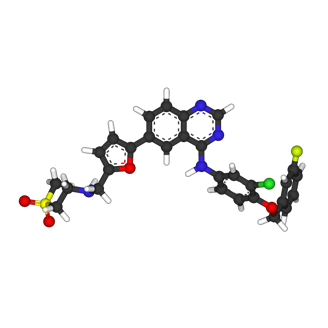Intermittent Lapatinib Hits Roadblock in HER2 Breast Cancer Study
A phase I study of intermittent oral lapatinib in patients with HER2-amplified breast cancer escalated up to 7,000 mg per day (shown to be effective in mouse models), found that plasma concentrations of the drug did not increase proportionately with the oral dose, impeding clinical translation of this method.
Ball-and-stick model of lapatinib

In an attempt to fully inactivate the HER2 kinase, researchers found that intermittent oral lapatinib in patients with HER2-amplified breast cancer could be escalated up to 7,000 mg per day with no dose limiting toxicities, a treatment regimen first tested effectively in mouse models.
Unfortunately, although the mouse models found intermittent high-dose therapy to be more efficacious than standard continuous low-dose therapy, this phase I analysis in humans showed that plasma concentrations of the drug did not increase proportionately with the oral dose, impeding clinical translation of this method.
“The effective and durable inhibition of the HER2-HER3 tumor driver is possible with HER family TKIs but requires much higher concentrations that completely inactivate HER2 catalytic function, leaving HER3 unphosphorylated despite significant upregulation,” wrote researchers led by A. Jo Chien, MD, of the University of California, San Francisco Helen Diller Family Comprehensive Cancer Center, in the Journal of Clinical Oncology.
Chien and colleagues sought to test the use of high-dose intermittent oral lapatinib in humans. They enrolled 40 women with advanced HER2-overexpressing breast cancer into a phase I dose-escalation study. Women received lapatinib on days 1 through 5 of repeating 14-day cycles. Patients completed a median of six cycles of therapy.
Researchers escalated lapatinib from 1,750 mg per day to 7,000 mg per day in the first six cohorts. No dose-limiting toxicities were reached. However, steady-state lapatinib plasma concentrations were not increased and were found to have plateaued.
“The observed plateau in exposure may be a result of solubility-limited absorption, a property common to most small-molecule TKIs; plasma protein binding; or other unknown pharmacokinetic processes,” the researchers wrote.
Seeing this, the researchers redesigned the study protocol to test the use of food, CYP3A4 inhibition and dose fractionation as methods to increase lapatinib bioavailability and systemic exposure. No increases were seen with food or with four times per day dosing. The researchers did report a 2.7-fold increase in lapatinib exposure with inhibition of CYP3A4 with ketoconazole.
Overall, six patients achieved a response. In addition, the researchers noted dramatic responses seen in the three patients who achieved lapatinib concentrations approaching 10,000 ng/mL.
“This is consistent with our driving hypothesis that the highly effective treatment of HER2-driven cancer requires near-complete inactivation of the HER2 kinase, a bar much higher than that observed for other kinase-driven cancers,” the researchers wrote. “Such an endeavor must await the development of agents with even higher potencies and formulations that can provide much higher systemic exposure than current agents.”
Newsletter
Stay up to date on recent advances in the multidisciplinary approach to cancer.





